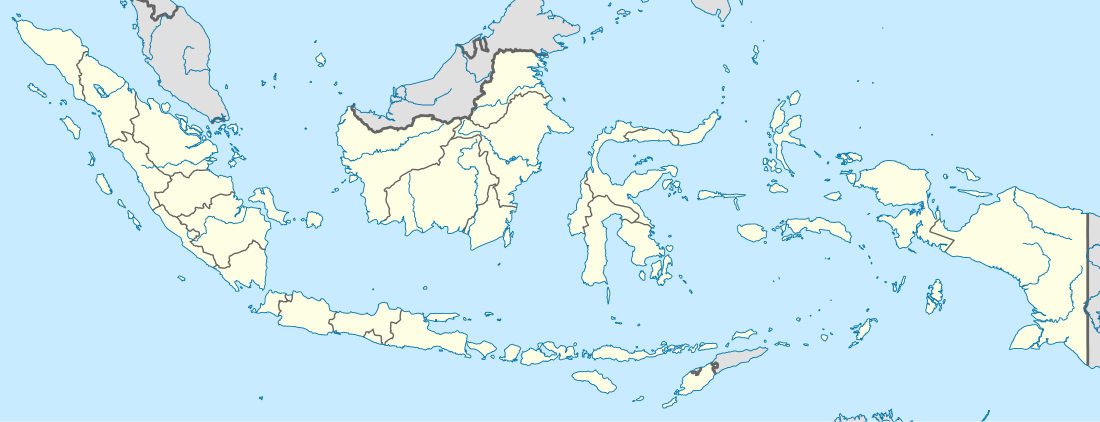Bagansiapiapi
| Bagansiapiapi | |
|---|---|
| Town | |
| Other transcription(s) | |
| • Chinese | 峇眼亞比 |
| • Pinyin | Bāyǎn yǎbǐ |
| • Jawi | باݢنسياڤي اڤي |
| Nickname(s): Bagan, Fish City | |
 Bagansiapiapi Location of Bagansiapiapi in Indonesia | |
| Coordinates: 2°10′N 100°49′E / 2.167°N 100.817°ECoordinates: 2°10′N 100°49′E / 2.167°N 100.817°E | |
| Country |
|
| Province | Riau |
| Regency | Rokan Hilir |
| Established | 1800s |
| Government | |
| Area.[1] | |
| • Total | 475,26 km2 (18,350 sq mi) |
| Population (30 June 2013)[2] | |
| • Total | 73,360 |
| • Density | 150/km2 (400/sq mi) |
| Demonym(s) | Bagan-kia (峇眼人) |
| Time zone | WIB (UTC+7) |
| • Summer (DST) | Not observed (UTC) |
| Website | Bagansiapiapi Community website |
| Bagansiapiapi | |||||||||||
| Traditional Chinese | 峇眼亞比 | ||||||||||
|---|---|---|---|---|---|---|---|---|---|---|---|
| Simplified Chinese | 峇眼亚比 | ||||||||||
| |||||||||||
Bagansiapiapi or simply known as Bagan (Chinese: 峇眼 , Hokkien: ba ngan) is a city in Riau province on the island of Sumatra, Indonesia. The city is the capital of Rokan Hilir Regency in the Riau Province and is located on the east coast of Sumatra, on the Rokan River delta across the strait west of Malacca and near Dumai.
History
The town was originally populated mainly by Chinese immigrants[3]:pp xii who arrived at the end of 19th and the beginning of 20th century. Initially eighteen Chinese nationals sailed to Bagansiapiapi around 200 years ago and settled on the delta. All were from the family named Hung (Hokkien) (Hong / Ang. in other dialects). More followed, searching for a new life and seeking to avoid the economic hardships prevalent in Hokkien (China) at that time.
Every year, the Chinese community celebrates the anniversary of Bagansiapiapi, on the 16th day, of the 5th month of the Lunar year, believing that the initial immigrant group landed at Bagansiapiapi on that day.
Most of the Chinese population are Hokkien, originating from Tang-Ua (TongAn, now part of E-Meng/Xiamen), Kim-Mng (JinMen/Kinmen), and Cin-Kang (JinJiang/Jinjiang). Some Teochew, living mainly in the southern part, and a minority of Khek/Hakka also populated the town. Most of Chinese population communicate using the Tang-Ua dialect of Hokkien.
Bagansiapiapi was one of the largest fish producers in the world during the late 1980s and early 1990s, ranking third in the world. Bagansiapiapi is also famous for swallow nest farming. Indonesia's bird's nests are famous for their quality and are well liked by consumers. This industry has led Bagansiapiapi into a new era of economic growth, involving investment, high activity in building construction and export growth.
In recent years, urbanization has been an issue. Most of the youth leave the town after high school to pursue a better life, or higher education in larger cities. They normally return for the traditional family reunion during the Chinese New Year celebrations.
Fishing Town
In the 1980s Bagansiapiapi was one of the largest fish producing towns in Indonesia, and the second highest producer of fish in the world, after Bergen in Norway.
The fishing industry started with the first wave of Chinese immigrants, attracted to the area by the availability of abundant fishing. The town's heyday came under the jurisdiction of the Dutch East Indies, around 1930, when the fisheries produced 300,000 tons of fish per year. The annual production has fallen since, being particularly affected by a collapse of fish numbers since the 1970s, by which time over 800 trawlers based in the town were fishing the Shunda Shelf.[4]:pp 41. The trawling ban in Indonesian waters, introduced in 1980, has had a significant effect on the economy of the town.[4]:pp 38.
Junk Burning festival
Junk burning, locally known as Bakar Tongkang (Chinese: 仪式 燃料 的 驳船) or in Hokkien language known as Go Gek Cap Lak (Chinese: : 五月 十六 日) is an annual Bagansiapiapi peoples ritual especially among Chinese ethnic that has been popular in foreign countries and included in the tourism thing like visit Indonesia calendar, celebrated every 16th in fifth of chinese calendar. Each year the ritual is able to bring tourists from Malaysia, Singapore, Thailand, Taiwan to Mainland China to visiting Bagansiapiapi. This annual event is now heavily promoted by the government as a source of Rokan Hilir tourism.[5]
Transportation
Transportation has been an area of concern for the government, as there is currently no airport. Bagansiapiapi is reached by road, being some 6 hours from Pekanbaru, capital of Riau, and 2.5 hours from Dumai. From North Sumatra and Medan the travel time by road is about 11 hours.
The local government has an ongoing policy of improving the town infrastructure, including the widening of roads and improving street lighting.
In June 2008, a new ferry line opened from Port Dickson, Malaysia, with a travel time of three hours.
Places around Bagansiapiapi
- Ing Hok Kiong Temple (永福宮)
- Jemur Island (Pak-ku) 北龜
- Sinaboi (Chiann-chui-kang; 正水港)
- Panipahan (Li-pa-ham : 籬笆蚶)
- Kubu
- Tanah Putih
- Sungai Nyamuk (Tua-kang 大港)
- Pulau Halang (Si-Kak-Pa; 四角笆)
- Pulau Berkley
- Ujung Simbul (Chhau-Ta-Pa; 臭乾笆)
- Sungai Bakau (Tua-Pa 大笆)
See also
References
- ↑ BPS-Statistics of Rokan Hilir Regency, (2014), Rokan Hilir In Figures, Page 7
- ↑ BPS-Statistics of Rokan Hilir Regency, (2014), Rokan Hilir In Figures, Page 61
- ↑ Daniel Pauly, Purwito Martosubroto (1996) Baseline studies of biodiversity: the fish resources of western Indonesia The WorldFish Center Retrieved 2010, May 19
- 1 2 Geronimo Silvestre, Daniel Pauly (1997) Status and management of tropical coastal fisheries in Asia The WorldFish Center ISBN 971-8709-02-9 Retrieved 2010, May 19
- ↑ "Warga Sambut Ritual Bakar Tongkang" Kompas.com, 28 Juni 2010